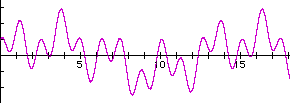
A value as a function of time

A value as a function of time
From the mathematical point of view, a signal is just a function: anything with a value that depends on a given number. In the case of the sound wave, the given number is the time and the value is the pressure.
In these terms, noise is a disorganised signal. The most perfectly disordered signal is referred to as 'white noise' and the value varies randomly with time so values at two very close times bear no relationship to each other. White noise is said to contain inifinite frequencies because it can change by any amount even in an infinitessimal time.

An attempt to portray white noise. Actually it
is sampled at a finite frequency.
White noise is not particularly useful for modelling and texturing. Usually we need some level of correlation between near values in our signals. We achieve this by smoothing the noise.
Several methods of smoothing have been described. We use convolution.